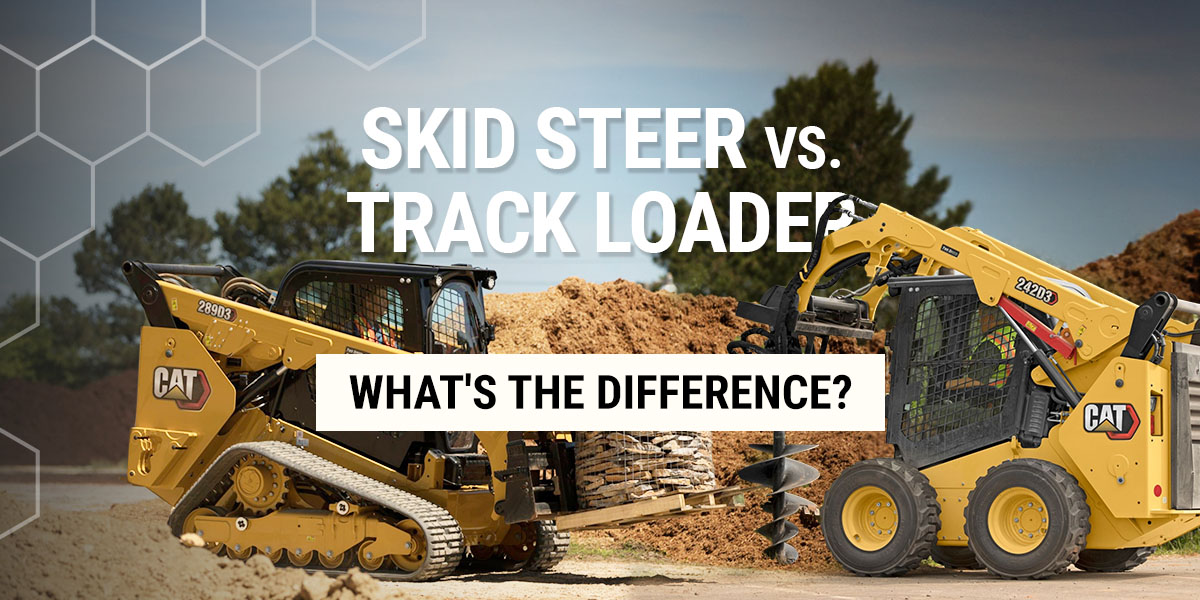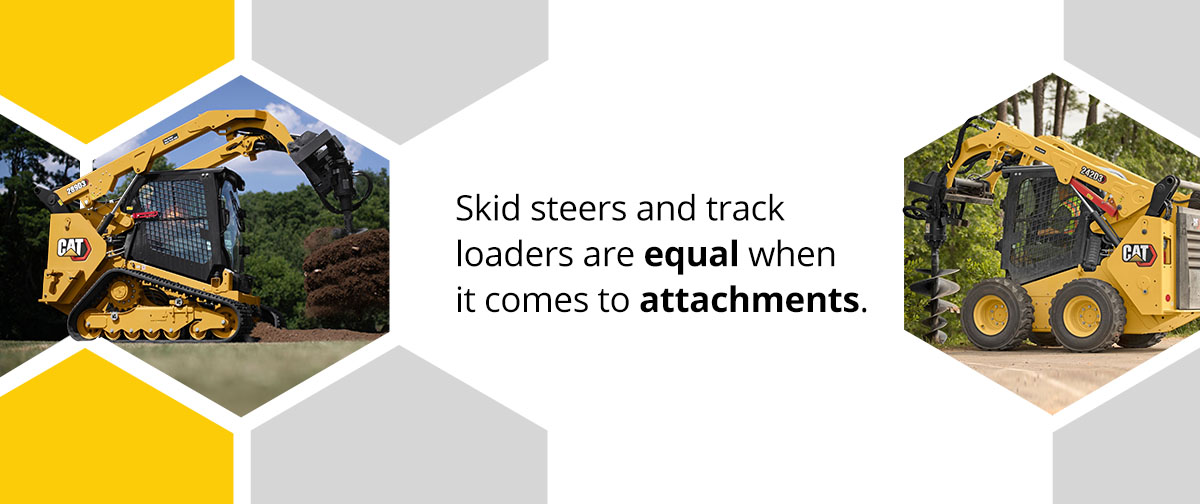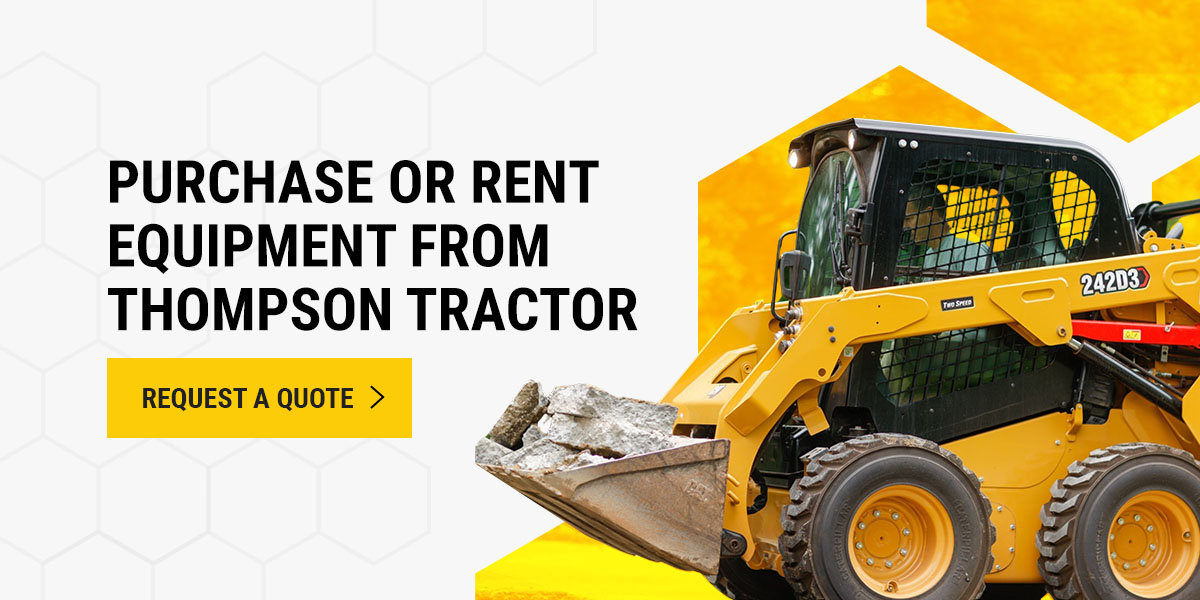
Comparing a skid steer and a track loader helps you choose the best machine for your next project. Skid steers and track loaders are land-moving machines that differ in design, making them ideal for different types of applications. A skid steer offers exceptional performance on hard surfaces, while a track loader moves with ease across soft terrain and uneven surfaces. Choosing the right machines enables you to work efficiently, protect your job sites, and help equipment last longer.
Understanding Skid Steers and Track Loaders
Skid steers and track loaders are land-clearing machines you can use for landscaping, agricultural, or construction applications. Both types of machines can hold attachments, move materials, dig, and grade. Before choosing a machine for your next job, it’s important to understand how each one operates.
What Is a Skid Steer?
A skid steer is a compact construction vehicle with a bucket or alternative attachment on the front. It operates on four wheels, and manufacturers place the wheels at a fixed angle. Because of this fixed angle, operators steer each side independently using the machines separate engines to make turns. Skid steers come in various sizes to meet different applications.
What Is a Track Loader?
Similar to a skid steer, a track loader is a compact machine that comes in various sizes and can hold different attachments. The primary difference between a track loader and a skid steer is that a track loader operates on two large tracks rather than four wheels.
Track Loader vs. Skid Steer
When you’re comparing a compact track loader versus a skid steer, you must consider how well each machine can perform in different applications. The terrain you work on, the weight you need to lift, and your overall budget play a role in the type of machine you need.
Consider the following factors before renting or purchasing your next machine:
Terrain
Track loaders are ideal when you work on soft, muddy, swampy, or grassy terrain. A track loader has lower pounds per square inch than a skid steer because it disperses its weight over each track’s entire width and length. This lighter weight allows you to float over surfaces without damaging terrain, so you can complete work and leave your project site’s terrain in the same or better shape than you left it.
Track loaders also perform well on uneven terrain. Since their tracks distribute weight evenly, they remain stable on challenging terrain such as hills.
Skid steers are excellent options if you need to work on hard, compact surfaces such as asphalt, gravel or rocky surfaces. Tracks wear easily if you operate a track loader on hard surfaces too often, but a skid steer’s wheels can handle this terrain with ease. Additionally, a skid steer’s wheels move better than a track loader across hard surfaces because they apply more ground pressure. This ground pressure also makes a skid steer the best option for snow removal applications.
You can clear snow with a track loader if you attach a heavy-duty snow blower to the front of it, but a skid steer typically moves easier through the snow. Rather than floating across the surface, a skid steer’s wheels sink down into the snow and provide the grip necessary to remain stable on slippery surfaces.
Versatility, Stability, and Maneuverability
Skid steers and track loaders are incredibly versatile and can operate in nearly any space. Whether you need to work in front of properties, behind structures, or in tight spaces, a skid steer or track loader can take you there. Track loaders offer slightly more maneuverability and stability than skid steers due to their traction and weight distribution. If you often work on soft terrain, opting for a track loader is the safest option.
Lift Capacity
It’s also important to consider lift capacities when comparing a track loader to a skid steer. Track loaders typically have higher lift capacities and carry more weight than skid steers due to their ground clearance. A track loader sits lower to the ground, allowing it to lift and transport heavier loads while maintaining stability.
While the weight capacities are only slightly different, a track loader can typically carry approximately 300 to 500 more per horsepower (HP) class. For example, you can expect a 65 HP track loader to carry between 300 and 500 pounds more at a time than a 65 HP skid steer. Because of their lift capacity, track loaders allow you to carry more material at a time and increase operational efficiency.
Attachments
Skid steers and track loaders are equal when it comes to attachments. Each machine can hold the same types of attachments to complete various jobs. Whether you use a track loader or skid steer, you can take advantage of attachments such as:
- Buckets
- Augers and bits
- Bale squeezers and spears
- Backhoes
- Manure forks and material spreaders
- Hay accumulators
- Feed pushers
- Jibs and booms
- Disc and drum mulchers
- Sweepers and brooms
- Breaker hammers
- Brush cutters
- Cold planers
- Grapples
- Log splitters
- Material rollers and pushers
- Pallet forks
- Rippers
- Vibratory rollers
- Rock diggers, road saws, and concrete grinders
- Root rakes
- Dozer and snow blades
- Snow blowers and pushers
- Tree shears, pullers, and grubbers
- Trenchers
- Mounting plates and adapters
Applications
Since skid steers and track loaders can hold the same attachments and perform various jobs, the terrain you work on is the primary factor you should focus on when it comes to application. Skid steers are popular for demolition projects because they operate well on hard, rocky surfaces. Track loaders are ideal if you perform most of your jobs on residential properties. Their lighter weight allows you to complete residential land-clearing projects without damaging lawns.
Budget
Your company’s budget is another considerable factor. Track loaders typically have a higher upfront cost than skid steers, and they can incur higher maintenance costs because tracks cost more to replace than tires. Track loaders offer the greatest fuel efficiency, so they are a good option if you want to reduce fuel consumption.
If cost is keeping you from investing in a machine, you can rent a high-quality track loader or skid steer to save money while using an industry-leading machine.
Should You Rent or Purchase a Machine?
While comparing a skid steer vs. a compact track loader is important, it’s also essential to determine whether you want to rent or purchase your next machine. Purchasing is a cost-effective option if you plan to use one type of machine frequently over an extended period of time. However, renting is the ideal option if you work on various terrains. For example, renting a track loader for a few residential jobs is an excellent way to save money if you typically work on hard surfaces. You can use the track loader for the few jobs you need and avoid paying for long-term maintenance costs.
Purchase or Rent Equipment From Thompson Tractor
Skid steers and track loaders are incredibly useful and versatile for numerous applications. Choosing the right machine for each project protects terrain, prevents equipment damage, and helps you complete your work efficiently. A track loader is perfect for jobs on soft or uneven terrain, and a skid steer performs exceptionally well on hard surfaces such as asphalt and concrete.
Thompson Tractor offers a wide selection of skid steers and track loaders to meet your needs. We can help you rent a Cat® track loader or skid steer for your next project, or we can help you choose the best equipment investment for your fleet. Our experts have the knowledge and experience to help you make an informed decision.
Request a quote or contact us to learn more about our available equipment and which machine is the right choice for you.



